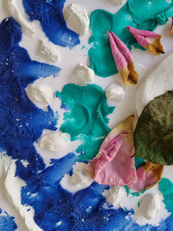
Balham Library Collaboration
Well-Being Through Creativity
3 Month Group Project
Design an experience for those suffering from mental health conditions to gain control & reduce negative emotions.
Anxiety can eventually rises to chronic or irreversible disorders like depression and suicide. It starts off small, but when it's not kept under control or maintained, it can grow out of control, making you feel helpless, bewildered, frightened, and confused. So, managing anxiety becomes a problem that has to be solved. It is important for individuals to understand their concerns in order to ask for advice and discover the most effective way to help overcome them.
How can we design an experience for people with these conditions that allows them to gain control and reduce symptoms of anxiety?
Questionnaires
Using the qualitative research method we interviewed people between the age groups of 20 to 30.
Creating a set of questions to discuss and explore others' understanding of anxiety, what triggers are involved, and how they cope with anxiety. Do they have their own method?
During the interviews, we asked them to draw a form of their negative emotions, Colour, size, representation, space, and environment.
Defining through Workshop Observations
Defining the objective by Investigating the methods used to treat mental health conditions and how they could be implemented during our research. We went to two different types of workshops and communities that help people with mental illnesses experience and observe the Users Journey and Behaviours.
Balam Library workshop
Participants' journey and experiences
The workshops were designed to provide anybody experiencing stress, anxiety, loneliness, or depression with free, easily accessible support. These workshops were led by qualified facilitators who used positive psychology, mindfulness, and art therapy techniques. guiding us through tasks while being compassionate and attentive to help us process thoughts and feelings in order to become more self-aware. They were designed to be entertaining, soothing, and educational.

During the start of the workshop, we noted many therapeutic approaches implemented into the course, such as applied relaxation therapy. When discussing our drawings/paintings, we used Mindfulness-Based Cognitive Therapy (MBCT) to explain our feelings, as well as Imagery Rehearsal Therapy (IRT). Using creative exercises, IRT was utilised to rescript our negative feelings.
Designed Method
This designed diagram draws inspiration from Van Schagen's "Vicious Circle of Nightmares." also known as Imagery Rehearsal Therapy. With this method, we are exploring how Negative emotions can be formed into visual forms to rewrite them physically using creative methods to create a coping mechanism.
The individual would explore their current feelings rather than revisit their prior traumas or dreams. This approach serves as a coping mechanism.

Behavioral Designing & Workshop Facilitating
The official workshop in collaboration with the Balham Library. For this workshop, the Balham Library sent out an Eventbrite invitation to those who had previously attended Katie's workshops to join our collaborative workshop. We wanted to engage with people outside of the university and communities that focus on mental health programs to see how they would react to the structure we designed.

During the setup of the workshop, we included bean bags for comfort when seated on the floor, creating a tranquil ambiance. There was also soft lighting, blankets, plants, and a diffuser with lavender-scented oil. These items contributed to the environment's cosiness, care, and relaxation.
Implementing a variety of creative activities to test our diagram. This allowed our participants to explore various items on the table, such as clay, markers, colouring paper, tissue paper, paint, lollipop sticks, and fresh flowers.
The Artifact Anaysis

The Design
Explore patterns utilising the shapes and forms developed from the workshop outcomes when producing their final form that depicts their coping mechanism.
Experimenting with texture and forms for the first time using the software blender, transforming the circle into shapes to represent the patterns from the workshop. Gradually shifting to produce calm and a visual ASMR.
Creating a 3D version of the immersive space, which is designed to represent an alternate world, for people with negative emotions to visit a little replica of paradise complete with natural components such as grass, trees, and rocks.
Leaflet of the guided exercises
Condense version of the methods we have explored and created throughout this project.
Feedback from our final participants;
“I feel floaty and connected with my energy as a person, connected to who I am”
“Let’s go crazy, let's be creative, let's be calm, let's make something pretty, let's go chaotic, a mix of energy put into the form - it helped me Get in touch with the emotion”
“It is therapeutic as it is difficult to convey and speak about myself, and using art and with crazy ways was a nice way to get in touch with my feelings”
“It was great to have people within the space as I was able to talk to people and be more of myself”
“Enjoyed the tunnel as it reminded me to go from reality to relaxation”
“Being put in a mysterious room and crawling into it felt exciting, and felt like revisiting my youth, especially with the different material”
These are the selected feedback of our final outcomes which reached our aims throughout this project.
Overall, the developed product and procedures are not meant to be a replacement for medical guidance, and anybody suffering from mental health difficulties should seek the assistance of a doctor or other professional health expert. However, we have created temporary solutions to assist them get by from day to day. Our toolkit includes a variety of methods for aiding, understanding behavioral, and visualising such forms of escape.



























